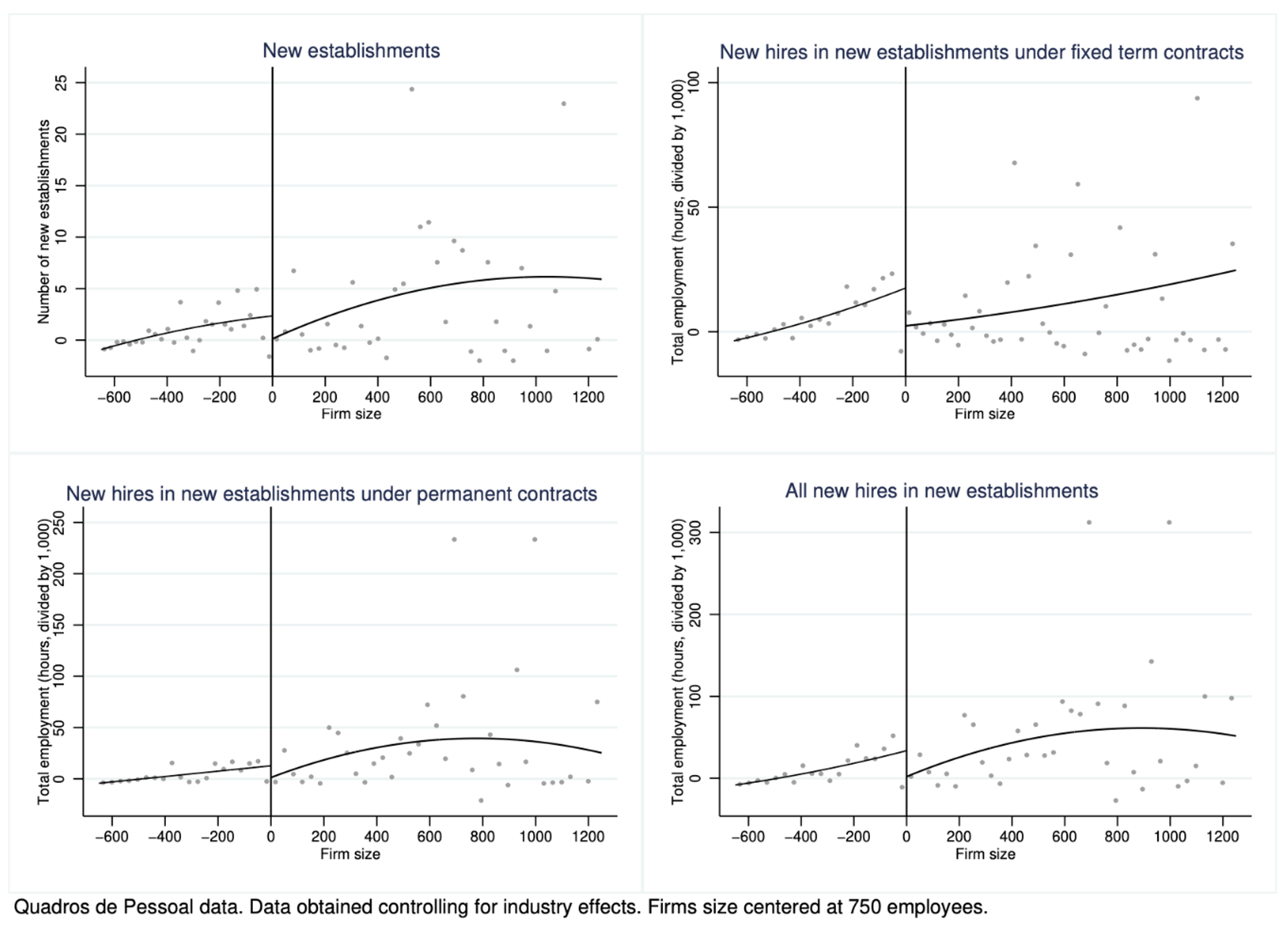In February 2009, Portugal sought to promote the use of open-ended contracts by reducing the range of circumstances under which fixed-term contracts could be used by large firms. Before this change, new establishments could hire workers under fixed-term contracts during the two years after their creation. After February 2009, only new firms with fewer than 750 employees could hire using fixed-term contracts. Newly established large firms could do so only to meet temporary needs or to hire long-term unemployed workers or workers searching for their first jobs.
This reform reversed the trend of previous policies that promoted, since the 1970s, hiring under fixed-term contracts and other types of atypical work while leaving open-ended contracts largely unchanged, especially in their legal protection against dismissal. This trend may have helped create segmented or two-tiered labour markets, where workers experience significant churning across multiple fixed-term contracts, leading to higher unemployment (Blanchard and Landier 2002, Cahuc and Postel-Vinay 2002, Boeri 2011). The resulting labour market institutional framework may have suboptimal outcomes, from both efficiency and equity points of view (Cabrales et al. 2014, Dolado et al. 2016). Hence, restricting fixed-term contracts would be desirable.
Drawing on linked employer-employee longitudinal data and regression discontinuity evaluation methods, in a new paper (Cahuc et al. 2022) we find that the reform successfully reduced the number of fixed-term contracts in new large firms (Figure 1). However, this was partly because the number of new firms being established also declined. Moreover, the number of permanent contracts in newly established large firms did not increase and, in some of our specifications, even decreased. When considering both fixed-term contracts and permanent contracts together, we find that they declined significantly.
Figure 1 Firms’ outcomes in the neighbourhood of the 750-employee threshold in October 2010
Notes: New establishments are created in 2009 or 2010. New employment contracts are those created from March 2009. Data obtained following controlling for ten one-digit industry effects and 0.1% winsorising.
Our results indicate that the fixed-term contract restriction did not encourage large firms to hire under permanent contracts instead. This indicates that there is a limited degree of substitutability between fixed-term contracts and permanent contracts. Some jobs that may be created under fixed-term contracts would necessarily have emerged if the fixed-term contract legal framework were not available, at least when the alternative of permanent contracts may be undesirable from the firm’s perspective.
We also find evidence of spillovers to smaller firms, which were not directly targeted by the reform: small firms more exposed to large firms – because of their common geographical and or sectoral location – tend to benefit more from large firms’ reduced hiring under fixed-term contracts, as the small firms end up hiring more workers.
In order to analyse these spillovers and their consequences, we build and estimate a directed search-and-matching model in which firms create establishments and hire temporary and permanent workers. The model accounts for direct effects on large firms of the regulation of temporary jobs, indirect effects on small firms not targeted by the regulation, and feedback effects on large firms induced by the behaviour of small firms. The model shows that small firms indirectly benefit from the reform: they create more jobs and more establishments. The presence of small firms that compete with large firms to hire workers thus amplifies the negative impact of the reform on large firms’ employment.
The model is used to evaluate the bias in the reduced-form estimates induced by the overlook of the general equilibrium effects. To identify the impact of the reform in line with the reduced form estimates, we calculate the creation and destruction of jobs in the transitional equilibrium two years after the reform. We then use the model to simulate the effect of the reform on total, permanent, and temporary steady-state employment.
We find that equilibrium effects have a small impact on the firm-level employment of small firms. To the extent that reduced form estimates rely on the comparison of firm-level employment of small and large firms, this implies that the bias in the reduced form estimates of the reform’s impact on the employment of large firms is small, at around 1%, in our context. However, since small firms account for 85% of total employment, their reaction has a sizeable effect on the changes in total employment induced by the reform: estimates of the reform’s impact on total employment – taking into account the general equilibrium effects – are about 13 times lower than those computed from reduced form estimates that assume small firms are not impacted (Table 1).
Table 1 Simulated impact of the reform on employment (% change)
Notes: Figures reported in the case where spillover effects are neglected are computed from the RDD estimates, assuming that employment of firms below 750 employees is not affected. Figures accounting for spillover effects are computed from the structural model.
From a methodological perspective, our results point to the importance of accounting for equilibrium effects to evaluate employment protection legislation, whether it applies to all firms or a subset of firms. This means, in particular, that it is unlikely that reduced form estimates yield reliable evaluations of the effects of employment protection legislation if they rely on different groups of firms or workers and assume that the control group is not affected by the reform.
The model is also useful to simulate the impact of the expansion of fixed-term contract regulation on new establishments of all firms. We find that the employment of all firms drops by 4.5 times more than in the reform restricted to large firms. However, large firms are less negatively impacted than when the reform targets them only because small firms lose a competitive advantage when they also must comply with the stringent regulation.
Another interest of the structural model is to provide insights on welfare. We find that the restrictions on fixed-term contract creation are detrimental to the welfare of unemployed workers because they will have fewer opportunities to find jobs. The drop in the welfare of unemployed workers reduces the outside option of all employees and consequently their welfare. We estimate that expanding the reform to all firms has a much bigger negative impact on the welfare of unemployed workers: their welfare drops by 5.4%, compared with when the reform applies to large firms only, in which their welfare drops by 0.7%. This finding indicates that flexibility at the margin – allowing firms to hire temporary workers – significantly improves labour market efficiency in our context.
References
Blanchard, O, and A Landier (2002), “The perverse effects of partial labour market reform: Fixed-term contracts in France”, Economic Journal 112(480): F214–F244.
Boeri, T (2011), “Institutional reforms and dualism in European labor markets”, in O Ashenfelter and D Card (eds.), Handbook of Labor Economics, Vol. 4B, Elsevier, chapter 13, pp. 1173–1236.
Cabrales, A, J Dolado and R Mora (2014), “Temporary contracts are bad for your cognitive health: Evidence from PIAAC”, VoxEU.org, 5 December.
Cahuc, P, and F Postel-Vinay (2002), “Temporary jobs, employment protection and labor market performance”, Labour Economics 9(1): 63–91.
Cahuc, P, P Carry, F Malherbet and P Martins (2022), “Employment effects of restricting fixed-term contracts: Theory and evidence”, CEPR Discussion Paper 16875.
Dolado, J, E Lalé and N Siassi (2016), “Replacing dual employment protection with a single labour contract”, VoxEU.org, 30 January.







